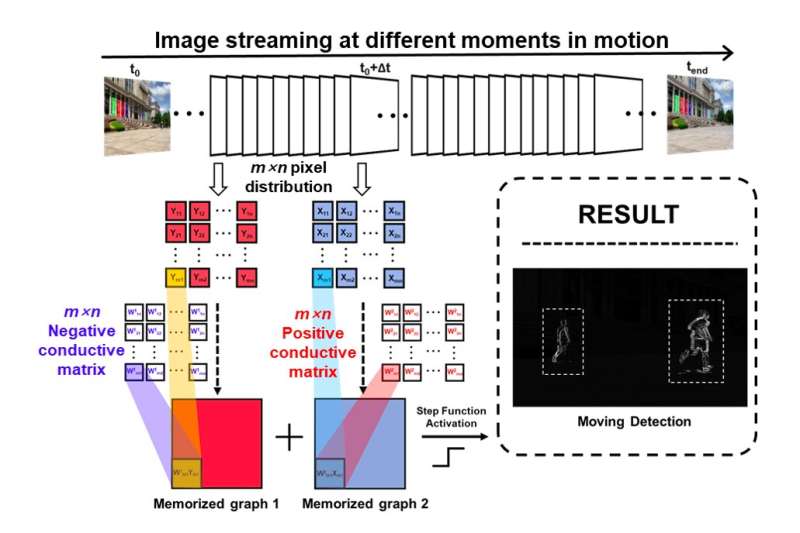
Devices that can automatically detect and recognize moving objects have numerous valuable applications, for instance, enhancing remote environmental monitoring. Most existing motion detection and recognition (MDR) technologies are based on image sensors made of complementary metal oxide semiconductors (CMOS). Compared to the human retina, these systems are often bulky and ineffective, as they require several hardware components for capturing, storing, and processing images.
Researchers at Fudan University and the Chinese Academy of Sciences have recently developed a new two-dimensional (2D) device inspired by the human retina that can detect movements, store motion data and analyze it. This all-in-one device, presented in a paper published in Nature Nanotechnology, is far less bulky than existing devices for motion recognition, yet it can recognize moving objects with high accuracy.
"Initially, we designed the specific structure that displayed a novel positive and negative photo-storage function," Peng Zhou, one of the researchers who carried out the study, told Phys.org. "After communicating with a professor specialized in artificial vision, we discovered the commonality between the structure and the retinal network and started the design and exploration of the artificial vision function like motion detection and edge detection."
Zhou and his colleagues set out to develop a device that can sense light, store data and perform computations, using hardware shaped like the human retina. The overreaching goal of their work was to achieve motion detection and recognition with a simpler and lighter device that consumes less power.
"The all-in-one device we created has two different modes based on the different stored carriers, which correspond to positive and negative optical response, respectively," Zhou explained. "Therefore, it can produce a positive/negative antagonistic non-volatile output under illumination. The integration of sensing, memory and computing is just similar to the mode of the human retinal network."
As the device created by Zhou and his colleagues partly resembles the human retina, the team evaluated its ability to perform some of the retina's functions, including motion and edge detection. Remarkably, they found that an artificial neural network running on the retina-inspired device could recognize moving objects with significantly greater accuracy than algorithms running on other devices.
"Previous retina-inspired devices only exhibited optical responses and could not store them efficiently, thus preventing time-domain computations for moving targets," Zhou said. "The all-in-one retino-morphic devices we proposed have non-volatile bipolar positive and negative photoconductivity, which enable unprecedented temporal differential processing and can therefore be applied to both moving targets and static images."
The researchers have already used their design to create a prototype of the retinomorphic device. In the future, this device could be used to remotely monitor a variety of environments or could be integrated in robots to enhance their motion detection and recognition capabilities.
"We have extended the functionality and applications of retina-inspired devices with 2D materials and provided prototype demonstrations for the integration of sensing, memory and computing," Zhou added. "We now plan to use the device we created as a model to build a hardware network system. At this stage, we are already working on exploring 2D system processes as well as constructing a test platform."
Explore further
© 2021 Science X Network
Citation: A retina-inspired device that can detect and recognize movements in the environment (2021, November 30) retrieved 30 November 2021 from https://ift.tt/3pw0nnZ
This document is subject to copyright. Apart from any fair dealing for the purpose of private study or research, no part may be reproduced without the written permission. The content is provided for information purposes only.
"device" - Google News
November 30, 2021 at 09:30PM
https://ift.tt/3pw0nnZ
A retina-inspired device that can detect and recognize movements in the environment - Phys.Org
"device" - Google News
https://ift.tt/2KSbrrl
https://ift.tt/2YsSbsy
Bagikan Berita Ini















0 Response to "A retina-inspired device that can detect and recognize movements in the environment - Phys.Org"
Post a Comment